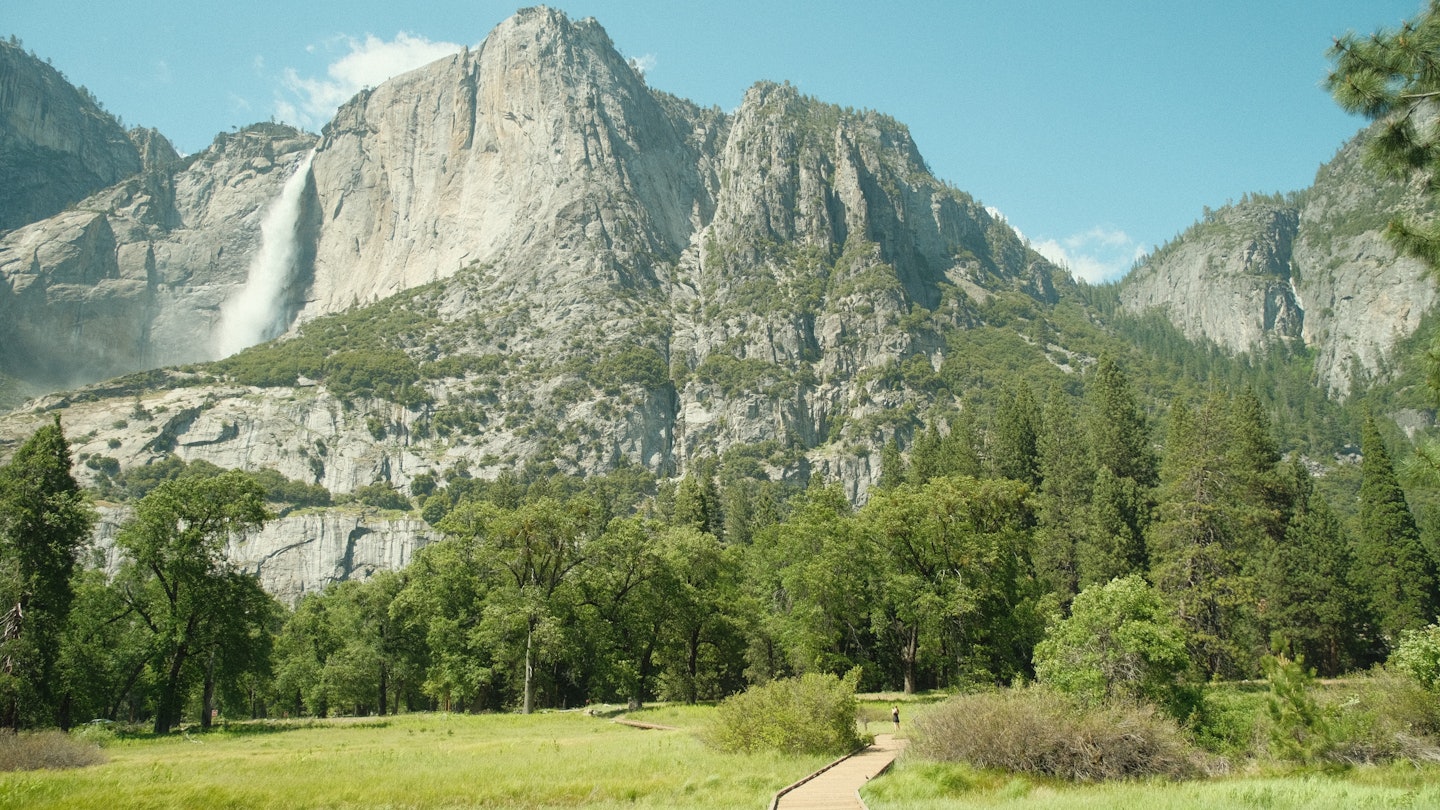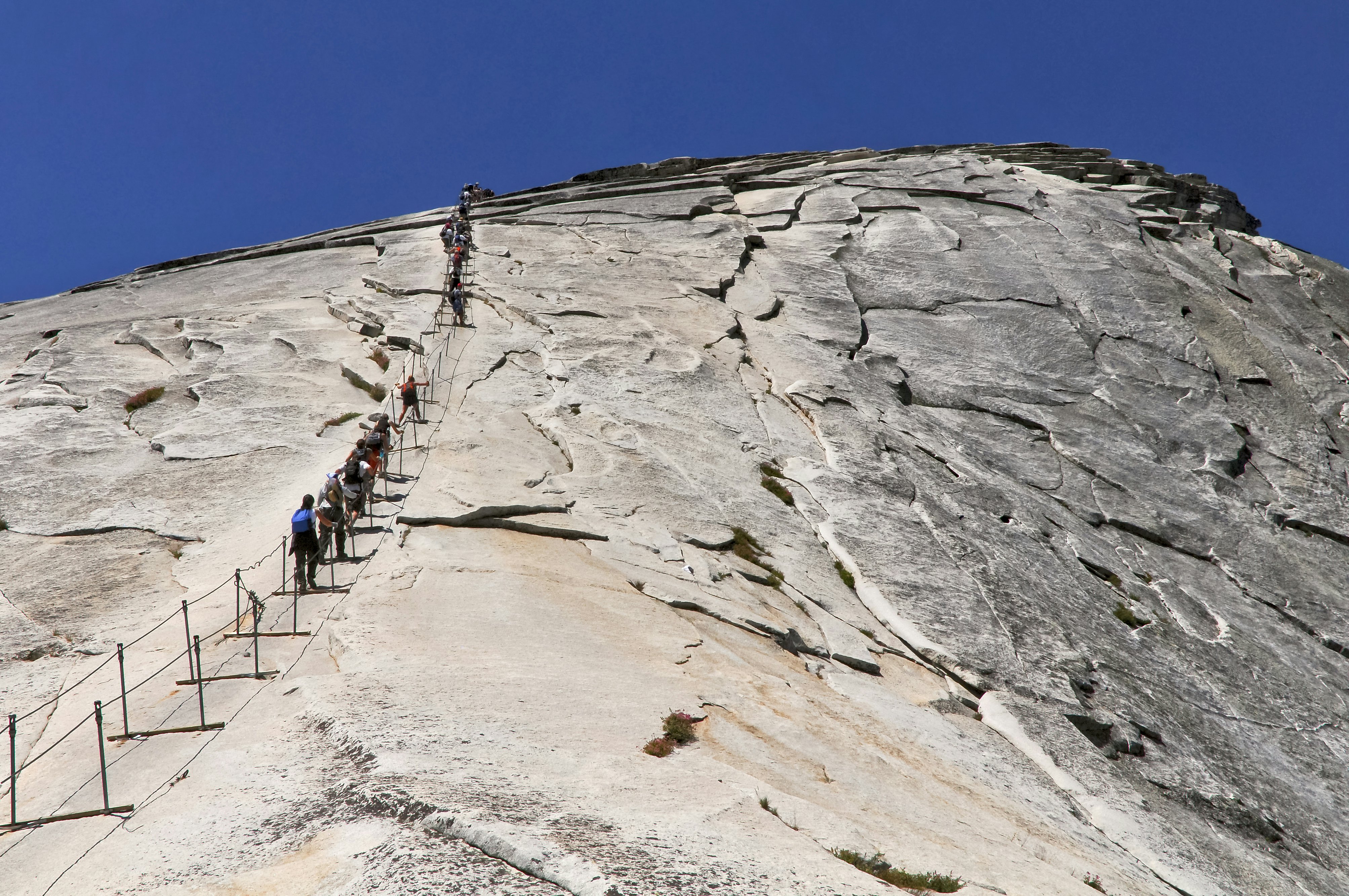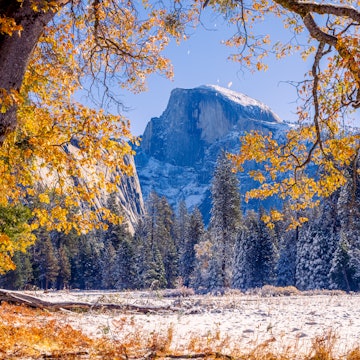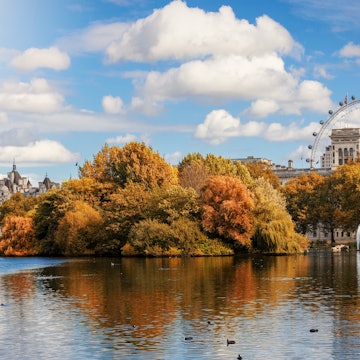

Yosemite National Park. sarah_xie7/Shutterstock
With its spectacular granite monoliths, plunging waterfalls and glacier-carved valleys, Yosemite National Park delivers the kind of epic scenery and adventure that sticks with you long after your trip ends. Most visitors arrive expecting to see the icons: Half Dome, El Capitan and Yosemite Falls. And while they absolutely deliver, what surprises many is how much variety lies beyond the postcard views of Yosemite Valley. Unspoiled high-country lakes, secluded groves of ancient sequoias, backcountry camps, off-the-radar swimming holes, even a ski area. Here, grandeur comes in many forms.
Despite its wild, untamed appearance, Yosemite is surprisingly accessible, with well-maintained roads, free shuttles and a tremendous range of experiences for every traveler, from veteran hikers to first-timers. The park is famously vast, and with so much to see, it can be tricky deciding what to tackle first. These 15 memorable things to do will help you zero in on the best of Yosemite.

1. Get a dramatic Yosemite welcome at Tunnel View
This jaw-dropping viewpoint delivers one of the most photographed vistas in the entire national park system. Yosemite Valley’s panoramic sweep greets you the moment you exit the Wawona Tunnel, El Capitan to the left, Bridalveil Fall to the right, Half Dome rising in the distance. We’ve somehow always managed to find parking, but the lot is fairly small, so mentally prepare yourself to have to drive past it and make a loop just in case.
Planning tip: Visitors are required to have reservations to enter Yosemite at times during peak season. Dates and times vary slightly every year; in 2025, they include 6am to 2pm Memorial Day and Labor Day weekends, plus June 15 through August 15.

2. Explore the park’s greatest hits in Yosemite Valley
This is the Yosemite you’ve seen in postcards: granite behemoths like El Capitan and Half Dome, Yosemite Falls thundering down from 2,425ft (739 meters), hiking and biking trails crisscrossing golden meadows. Yosemite Valley serves as the park’s bustling hub, with a scenic loop drive, multiple accommodation and dining options (Yosemite Valley Lodge alone has several; Base Camp Eatery is usually my go-to), bike rentals, guided tours and trailheads for several popular hikes. Explore the valley on foot via the Valley Loop Trail, watch for wildlife in Cook’s Meadow, snap photos of Yosemite Valley Chapel (and catch Sunday services!) and pop into the Ansel Adams Gallery, open year-round.
Planning tip: The free Yosemite Valley shuttle loops around the valley from 7am to 10pm daily in the summer, with stops every 12 to 22 minutes.
3. Stretch your legs without breaking a sweat at Mirror Lake
One of Yosemite’s easiest hikes (it’s almost entirely flat, a rarity in this park), Mirror Lake offers postcard-worthy views with minimal effort. Access the trailhead from Curry Village, the Yosemite Valley Loop Trail or shuttle stop #17, Mirror Lake Trailhead. From there, a paved 1-mile service road leads to the lake, making the first stretch ideal for wheelchairs, strollers and bicycles. Most visitors stop at the lake itself, but continuing on the 5-mile loop around it gets you away from the crowds.
Planning tip: By late summer, Mirror Lake isn’t usually much of a lake at all. It often dries up by August and isn’t full again until springtime. You can also reach the lake year-round, and winter offers a memorable frozen wonderland scene.

4. Get a taste of the iconic Mist Trail at Vernal Fall
The 317-foot-tall Vernal Fall is one of the most powerful, rewarding waterfalls in the park, and you won’t see it from the valley floor. Starting from Happy Isles (shuttle stop #16 or a short walk from Curry Village), hike about a mile to the Vernal Fall footbridge for a view from the cascade’s base. To reach the top, continue up the trail’s famously misty granite staircase – over 600 steps perpetually slick with waterfall spray. The climb is short but strenuous, and in spring, the mist is more of a drench.
Planning tip: For a bigger challenge, continue on the Mist Trail past Vernal Fall to the top of 594-foot Nevada Fall. The out-and-back route totals 5.4 miles with around 2000ft of elevation gain.
5. Cruise Glacier Point Road’s unforgettable panoramic overlooks
This scenic 16-mile road leads to some of Yosemite’s most arresting viewpoints, including legendary Glacier Point, arguably the best sunset spot anywhere. Soak up in-your-face views of Half Dome and vistas stretching across Yosemite Valley, Yosemite Falls and Vernal Fall. Open roughly May through November, Glacier Point Road also briefly (typically just a few days) opens to cyclists only each spring before vehicles are allowed, offering a rare opportunity to experience Yosemite without traffic. Along the way, tackle short hikes like the one to Taft Point and Sentinel Dome.
Planning tip: If you prefer not to drive, take the Glacier Point Tour from Yosemite Valley Lodge. The round-trip tour is four hours, but you can also book a one-way ticket and hike back down into Yosemite Valley via the Panorama Trail or Four-Mile Trail.

6. Capture sunset reflections from Valley View
Tucked along the Merced River just off Northside Drive, unmarked Valley View is one of Yosemite’s most photogenic vistas. You’ll have incredible views of El Capitan rising to your left, with Cathedral Rocks, Sentinel Rock, the Three Brothers and Bridalveil Fall (in spring and early summer) across the water, all perfectly framed by the river in the foreground. It’s a stunning view any time of day, but the light turns golden and the scene transforms into something genuinely magical at sunset.
Planning tip: Arrive about an hour before sunset to stake out a spot. This is one of the park’s most popular spots for golden hour, especially for photographers.
7. Walk among giants in the Mariposa Grove of Giant Sequoias
The largest of Yosemite’s three sequoia groves, Mariposa Grove is home to over 500 ancient giant sequoias. Some of the most famous residents include the 3,000-year-old Grizzly Giant and the California Tunnel Tree. Several trails lead through the grove and wind past clusters of towering sequoias, from the short, accessible Big Trees Loop to the 2-mile Grizzly Giant Loop or challenging Mariposa Grove Trail.
Mariposa Grove is tranquil and reflective, allowing visitors to experience Yosemite’s splendor at a quiet, contemplative pace. A free shuttle runs from the Mariposa Grove Welcome Plaza to Mariposa Grove from mid-April through November. In the winter, visitors can access the grove by hiking or snowshoeing 2 miles each way on Mariposa Grove Road.
Planning tip: Mariposa Grove is just inside Yosemite’s South Entrance, closest to Fish Camp and Oakhurst and not close to much else in the park other than Wawona. Plan your visit on your way in or out for the day, or pair it with a trip to the Wawona swinging bridge (#8 below).
8. Hike to an under-the-radar swimming hole near Wawona Swinging Bridge
This 40-foot wooden swinging bridge – yes, you’ll feel it sway under your feet – crosses the South Fork of the Merced River. The peaceful ¾-mile riverside trail is nearly flat, making it ideal for families or a break between challenging hikes. In late spring, the river rushes with a thunderous roar; by mid-summer, shallow emerald pools below the bridge turn it into a blissful, off-the-beaten-path swimming hole. It should go without saying, but don’t even attempt to swim when rapids are present.
Planning tip: Combine the swinging bridge with a hike to Chilnualna Falls. Find both trailheads on Chilnualna Falls Road. Do the waterfall hike first, then cool off at the bridge.
9. Drive Tioga Road to discover Yosemite’s quiet side
Climbing out of Yosemite Valley and into the high country, Tioga Road (Highway 120) presents a vastly different perspective on the park. The winding 47-mile road connects Crane Flat to Tioga Pass, carving through a landscape of subalpine forest, granite domes, wildflower meadows and glacier-carved lakes. Highlights include crystal-clear Tenaya Lake, wildflower-blanketed Tuolumne Meadows, Soda Springs and the dramatic Olmsted Point, where the valley sprawls out below.
Tioga Road typically opens a few weeks after Glacier Point Road, usually late May or June, and closes by November. From mid-June through early September, the Yosemite Valley–Tuolumne Meadows hikers bus offers one-way rides from Yosemite Valley to key sites and trailheads along the road.
Planning tip: For a ‘secret’ viewpoint, cross the road from the Olmsted Point parking area and hike up the granite dome behind it. From the top, take in sweeping views of Tenaya Lake, Cloud’s Rest, Mount Hoffman and a dramatic angle on Half Dome.

10. Stay in the famous tent cabins and enjoy the social scene in Curry Village
Directly under Glacier Point in Yosemite Valley, Curry Village is a lively hub that puts you close to some of the park’s most popular hikes, including the Mist Trail, Vernal Fall and Half Dome. Lodging ranges from the iconic tent cabins (four of us stayed in one the night before tackling Half Dome to avoid traveling to the trailhead) to traditional wooden cabins and lodge-style rooms.
Beyond a place to sleep, Curry Village functions like a small town. Start your days at Coffee Corner, grab tacos from Taqueria at The Meadow Grill, sip superb cocktails at Bar 1899 and refuel post-hike with a Half Dome pizza from the Pizza Deck. No one will judge if you eat the entire thing. Snag a rocking chair on the porch if you can. Curry Village also has a well-stocked general store, bike rentals with child trailers and helmets and even an outdoor swimming pool. In winter, pop by for a spin around the old-school ice-skating rink, complete with cozy fire pits.
Planning tip: The unheated tent cabins offer the best in-park accommodation bargain by far. They have lights but no electrical outlets, so bring a light-bulb socket adapter and a short extension cord.
11. Get fancy for dinner or drinks at The Ahwahnee
Framed by Yosemite Falls, Half Dome and Glacier Point, The Ahwahnee is one of the National Park Service’s crown jewels. Its grand stone and timber architecture blends with the surroundings, and the soaring ceilings, floor-to-ceiling windows and massive fireplaces inside make the hotel a destination in its own right. Overnight stays are a major splurge for most people, but anyone can wander the grounds or enjoy a drink or meal in The Ahwahnee Dining Room.
Planning tip: It’s often easier to score a seat at The Ahwahnee Bar than in the dining room. Plus, the bar is more casual – if you eat dinner in the restaurant, men must wear pants and a collared shirt; women are required to wear a dress, a skirt or blouse and pants.
12. Chase waterfalls away from the crowds at Hetch Hetchy Reservoir
Best for ditching the crowds
Over one hour from Yosemite Valley, Hetch Hetchy sees a fraction of park visitors – around 1% annually. The glacial valley that once bore a striking resemblance to Yosemite Valley was flooded in the early 20th century to create a reservoir to supplement San Francisco’s water supply. The massive O’Shaughnessy Dam serves as the gateway to one of the park’s most underrated landscapes.
Steep granite domes and thundering waterfalls, including 1080ft Wapama Falls, ring the reservoir. The 5-mile round-trip hike to Wapama is one of Hetch Hetchy’s highlights, with the trail bringing hikers close enough to get sprayed. Lookout Point is another popular hike. Birders also find this section of the park rewarding, with over 100 bird species calling it home.
Planning tip: Hetch Hetchy is the only area in Yosemite that doesn’t require a reservation during peak season. Its lower elevation also means it tends to open a bit earlier in the spring and stay accessible later into fall.
13. Take a dip with a view at Sentinel Beach
Tucked along the Merced River in Yosemite Valley, Sentinel Beach offers a peaceful spot to take in iconic views of Upper Yosemite Fall and Sentinel Dome. When water levels drop in late summer and fall, a wide sandy beach emerges – perfect for picnicking, relaxing, or dipping your toes in the river. At other times of year, especially during spring runoff, the beach may be completely underwater or not visible at all. Still, its dedicated picnic area with tables and BBQ grills makes it a great riverside stop when conditions allow.
Planning tip: Typically in July and August, you can rent two-to-four-person rafts at the Curry Village Activity desk and paddle 3 miles to Sentinel Beach. Shuttles pick up at the beach and return to Curry Village.

14. Hike the infamous Half Dome Cables Route
Few hikes in Yosemite – or anywhere, really – deliver like the trek up Half Dome. None of the 14 to 18 mile hike is for the faint of heart, but the final ascent via the storied Cables Route is especially challenging: hikers must scale slick, near-vertical granite using nothing but steel cables bolted into the rock, with sheer drop-offs on either side. For those who earn it, the sense of accomplishment and views from the summit are unforgettable. I’ve done it myself, and honestly still can’t believe I did.
Hikers must score hard-to-get permits to climb the cables, although you can hike to the base of Half Dome without one. Truly, though, why go all that way to not conquer the cables? Apply in March every year for the best odds for the season ahead; if you don’t get one, you can also apply for the daily lottery two days ahead.
Planning tip: Consider camping at Little Yosemite Valley the night before to split the hike into two days. Our group did the entire trail as a day hike on one brutally hot September day and unanimously agreed we’d camp next time. To do this, you need a wilderness permit (as opposed to a day hike permit). Bonus: if you snag one, you can simply add a Half Dome permit to your reservation – no need to score reservations for both the campground and hike separately.
15. Play in a winter wonderland at Badger Pass Ski Area
Curry Village isn’t Yosemite’s only winter playground. Open roughly mid-December through March, Badger Pass has beginner-friendly downhill skiing, snowboarding, tubing, cross-country trails and snowshoeing. It’s like a ski resort, but refreshingly low-key. You can also take a variety of lessons through the ski school or explore untouched terrain on a backcountry ski tour. Even if you don’t hit the slopes, gear rentals, warm drinks and souvenirs in the day lodge make this a worthy hangout.
Planning tip: A free shuttle runs between Yosemite Valley and Badger Pass daily whenever the ski area is open. It’s a 40-minute drive, running approximately 8am to 4:30pm.
















